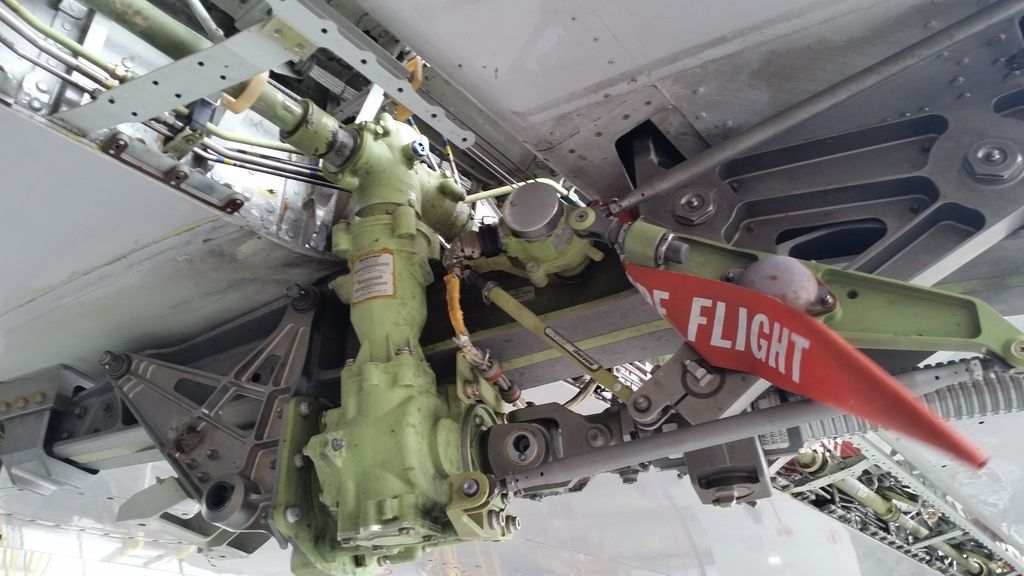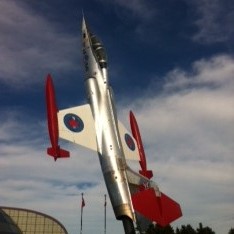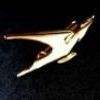Moderators: richierich, ua900, PanAm_DC10, hOMSaR
-

- DocLightning
- Posts: 22843
- Joined:
737 flaps mechanism
https://www.youtube.com/watch?v=cld62K4ntbk
Can someone explain what the rotating bar is? Any other useful insights?
Can someone explain what the rotating bar is? Any other useful insights?
Re: 737 flaps mechanism
Flap jackscrew drive?
That's more of a gess though. I don't have the docs on me and never studied this in particular.
That's more of a gess though. I don't have the docs on me and never studied this in particular.
Re: 737 flaps mechanism
I always wondered how that all worked, more complicated than I thought,looks like a giant driveshaft to drive the other components to make it all work .
Re: 737 flaps mechanism
DocLightning wrote:https://www.youtube.com/watch?v=cld62K4ntbk
Can someone explain what the rotating bar is? Any other useful insights?
It's the Flap Drive Torque Tube. Has teeth at each end that match teeth in the gearboxes, which then turn the Flap Jackscrews which move the flaps up and down..
Flap Torque Tube

Yellow arrows point to the jackscrews, green arrows point to torque tubes, blue flap track, red flaps, gray hydraulic motor, pink flap drive unit IIRC nomenclature

-

- DocLightning
- Posts: 22843
- Joined:
Re: 737 flaps mechanism
[quote="CALTECH"][/quote]
Oh wow. Thank you so much, CALTECH. That's amazing.
Oh wow. Thank you so much, CALTECH. That's amazing.
-

- DocLightning
- Posts: 22843
- Joined:
Re: 737 flaps mechanism
Classa64 wrote:I always wondered how that all worked, more complicated than I thought,looks like a giant driveshaft to drive the other components to make it all work .
It kind of makes sense. Even a small asymmetry in flaps position can lead to loss of control as we saw in that South American 727 a few weeks ago. So it would make sense for a linked mechanism to absolutely ensure that both wings have exactly the same flap setting at all times.
Re: 737 flaps mechanism
Before reconnecting the torque tubes to the motor, run the motor for twenty minutes first, then connect tubes. If you don't do this you'll get a flap jam because that motor creeps very slowly till it is fully up.
Re: 737 flaps mechanism
Balerit wrote:Before reconnecting the torque tubes to the motor, run the motor for twenty minutes first, then connect tubes. If you don't do this you'll get a flap jam because that motor creeps very slowly till it is fully up.
2 minutes when adjusting hydraulically, not 20. Electrically, no wait. As in the AMM. "When you retract the trailing edge flaps with hydraulic power, it is necessary to stop for two minutes after you move the flaps. The flaps can move a small distance for 2 minutes after extension or retraction."
Re: 737 flaps mechanism
DocLightning wrote:Classa64 wrote:I always wondered how that all worked, more complicated than I thought,looks like a giant driveshaft to drive the other components to make it all work .
It kind of makes sense. Even a small asymmetry in flaps position can lead to loss of control as we saw in that South American 727 a few weeks ago. So it would make sense for a linked mechanism to absolutely ensure that both wings have exactly the same flap setting at all times.
When the difference between the two flap position transmitters is greater than 9 degrees between the 2 resolvers, flap asymmetry is triggered and the flap bypass valve opens and stops the flaps from moving. It will reset the asymmetry condition when the resolver difference gets below 7.5 degrees.
AMM
"During the normal operation of the TE flaps, the TE flaps are mechanically controlled and hydraulically operated. During the alternate operation, the TE flaps are electrically controlled and electrically operated.
The flap load relief function retracts the TE flaps at high airspeeds to prevent structural damage to the TE flaps and wing structures.
The TE flap skew and asymmetry detection functions stop the TE flap hydraulic operation if the TE flaps are not aligned. The TE flap uncommanded motion (UCM) detection function stops the TE flap hydraulic operation if the TE flaps move away from their commanded position."
"The FSEU monitors for a flap asymmetry condition and a flap skew condition. There is a flap asymmetry condition if a flap on one wing does not align with the symmetrical flap on the other wing. There is a flap skew condition if the inboard end of a flap does not align with the outboard end."
-

- Tristarsteve
- Posts: 3805
- Joined:
Re: 737 flaps mechanism
Even a small asymmetry in flaps position can lead to loss of control
I was once involved in a CAA Air test after a D check on a B737-200. We rigged the flaps and sent the aircraft out on it's test flight. It returned with a problem. The left wing dropped before the aircraft stalled, even with full right aileron.
We sat and thought and read. and in the end we adjusted the flap torque tubes at the motor to the limits of their allowance. This brought the left flap out, and the right flap in. The difference was a couple of mm. The aircraft passed the next air test. I was amazed at the time how a really small adjustment made such a big difference to the trim, and understood fully why guarding against flap asymmetry is so important.
I was once involved in a CAA Air test after a D check on a B737-200. We rigged the flaps and sent the aircraft out on it's test flight. It returned with a problem. The left wing dropped before the aircraft stalled, even with full right aileron.
We sat and thought and read. and in the end we adjusted the flap torque tubes at the motor to the limits of their allowance. This brought the left flap out, and the right flap in. The difference was a couple of mm. The aircraft passed the next air test. I was amazed at the time how a really small adjustment made such a big difference to the trim, and understood fully why guarding against flap asymmetry is so important.
Re: 737 flaps mechanism
In the Video farther in, it shows the big motor driving two shafts out the left and the right, whitch are hooked to shafts and gear boxes to move the flaps and it all looks rigid and all mechanical. I could see if one mechanism is worn it may cause more flap or less depending on wind load....
How is it possible to get an asymmetry ?
I guess I am asking how does it know one flap is extended and one not when a jammed one would cause the whole mechanism to jam on both sides since its driven by one motor?
C.
How is it possible to get an asymmetry ?
I guess I am asking how does it know one flap is extended and one not when a jammed one would cause the whole mechanism to jam on both sides since its driven by one motor?
C.
Re: 737 flaps mechanism
CALTECH wrote:DocLightning wrote:Classa64 wrote:I always wondered how that all worked, more complicated than I thought,looks like a giant driveshaft to drive the other components to make it all work .
It kind of makes sense. Even a small asymmetry in flaps position can lead to loss of control as we saw in that South American 727 a few weeks ago. So it would make sense for a linked mechanism to absolutely ensure that both wings have exactly the same flap setting at all times.
When the difference between the two flap position transmitters is greater than 9 degrees between the 2 resolvers, flap asymmetry is triggered and the flap bypass valve opens and stops the flaps from moving. It will reset the asymmetry condition when the resolver difference gets below 7.5 degrees.
AMM
"During the normal operation of the TE flaps, the TE flaps are mechanically controlled and hydraulically operated. During the alternate operation, the TE flaps are electrically controlled and electrically operated.
The flap load relief function retracts the TE flaps at high airspeeds to prevent structural damage to the TE flaps and wing structures.
The TE flap skew and asymmetry detection functions stop the TE flap hydraulic operation if the TE flaps are not aligned. The TE flap uncommanded motion (UCM) detection function stops the TE flap hydraulic operation if the TE flaps move away from their commanded position."
"The FSEU monitors for a flap asymmetry condition and a flap skew condition. There is a flap asymmetry condition if a flap on one wing does not align with the symmetrical flap on the other wing. There is a flap skew condition if the inboard end of a flap does not align with the outboard end."
That's why I love the MD11... no ballscrews, no torque tubes. Just 2 hydraulic acutuators per flap, some cables and clappers and simple hinges. Let's not talk about the slats though
-

- OldAeroGuy
- Posts: 3928
- Joined:
Re: 737 flaps mechanism
Classa64 wrote:In the Video farther in, it shows the big motor driving two shafts out the left and the right, whitch are hooked to shafts and gear boxes to move the flaps and it all looks rigid and all mechanical. I could see if one mechanism is worn it may cause more flap or less depending on wind load....
How is it possible to get an asymmetry ?
I guess I am asking how does it know one flap is extended and one not when a jammed one would cause the whole mechanism to jam on both sides since its driven by one motor?
C.
There are several ways to get a non-jam asymmetry. One would be to have the torque tube fail between the outboard jackscrew on the inboard flap and the inboard jackscrew of the outboard flap.
In this case, the inboard flap would actuate normally but the outboard flap wouldn't move.
That's why part of the asymmetry detection system has torque tube rev counters at the outboard ends of the torque tubes on each wing. If the rev counters don't agree, it means there is a torque tube failure/disconnect and the drive motor is shut down.
Re: 737 flaps mechanism
Here's a good photo showing the torque tube, gearbox, 'U-joint', jackscrew gimbal, jackscrew, flap track and flap carriage. One can see how coming off the torque tube, the drive components make two 90' changes getting to the jackscrew.


Re: 737 flaps mechanism
I once had to sort out a 737 flying one wing low after I don't know how many people tried. I measured everything and found one i/b sailboat fairing hanging about 5mm lower than the others. Rigged it correctly and this solved the issue.
Re: 737 flaps mechanism
CALTECH wrote:Balerit wrote:Before reconnecting the torque tubes to the motor, run the motor for twenty minutes first, then connect tubes. If you don't do this you'll get a flap jam because that motor creeps very slowly till it is fully up.
2 minutes when adjusting hydraulically, not 20. Electrically, no wait. As in the AMM. "When you retract the trailing edge flaps with hydraulic power, it is necessary to stop for two minutes after you move the flaps. The flaps can move a small distance for 2 minutes after extension or retraction."
Good luck with that, seen it happen before, 20 years experience helps with the small things, maybe the newer aircraft motors don't creep but the old ones did.
Re: 737 flaps mechanism
Balerit wrote:CALTECH wrote:Balerit wrote:Before reconnecting the torque tubes to the motor, run the motor for twenty minutes first, then connect tubes. If you don't do this you'll get a flap jam because that motor creeps very slowly till it is fully up.
2 minutes when adjusting hydraulically, not 20. Electrically, no wait. As in the AMM. "When you retract the trailing edge flaps with hydraulic power, it is necessary to stop for two minutes after you move the flaps. The flaps can move a small distance for 2 minutes after extension or retraction."
Good luck with that, seen it happen before, 20 years experience helps with the small things, maybe the newer aircraft motors don't creep but the old ones did.
No good luck needed, if it's still creeping after 2 minutes which I have never seen, something is seriously wrong. That's after 37 years experience of doing the small and large things, like rigging B-52G/H, KC-135A, and 727-100/-200 flaps, and have never waited 20 minutes for flaps to reach full up or down for checks.
Re: 737 flaps mechanism
OldAeroGuy wrote:Classa64 wrote:In the Video farther in, it shows the big motor driving two shafts out the left and the right, whitch are hooked to shafts and gear boxes to move the flaps and it all looks rigid and all mechanical. I could see if one mechanism is worn it may cause more flap or less depending on wind load....
How is it possible to get an asymmetry ?
I guess I am asking how does it know one flap is extended and one not when a jammed one would cause the whole mechanism to jam on both sides since its driven by one motor?
C.
There are several ways to get a non-jam asymmetry. One would be to have the torque tube fail between the outboard jackscrew on the inboard flap and the inboard jackscrew of the outboard flap.
In this case, the inboard flap would actuate normally but the outboard flap wouldn't move.
That's why part of the asymmetry detection system has torque tube rev counters at the outboard ends of the torque tubes on each wing. If the rev counters don't agree, it means there is a torque tube failure/disconnect and the drive motor is shut down.
Ahhhh got it, never thought about the torque tube breaking,
Thanks !
Great Pics CALTECH, really helps out in visualizing everything
Who is online
Users browsing this forum: No registered users and 41 guests





